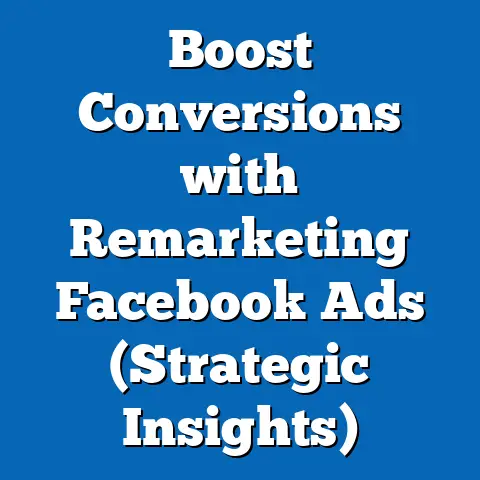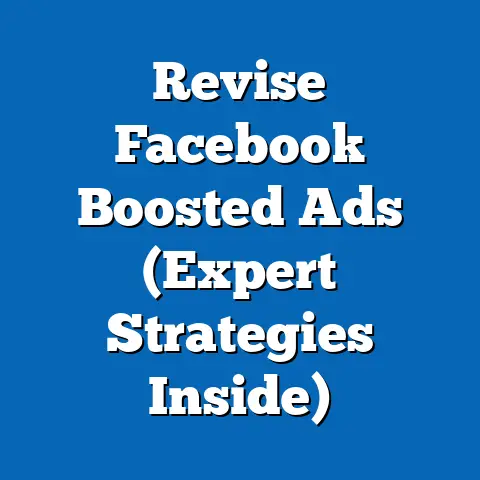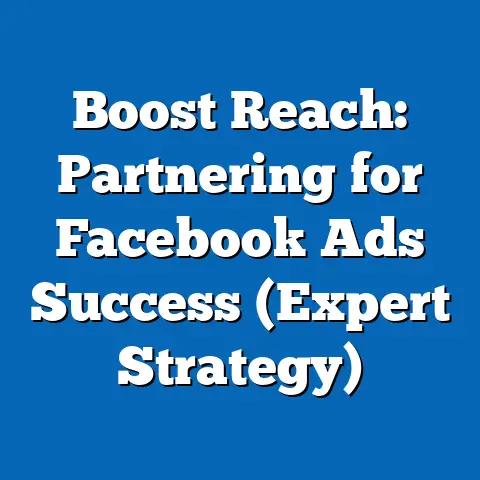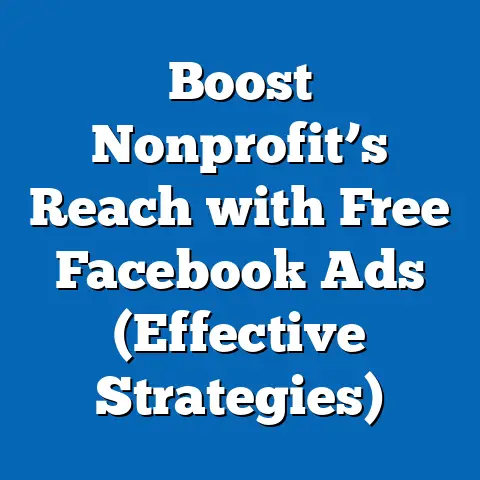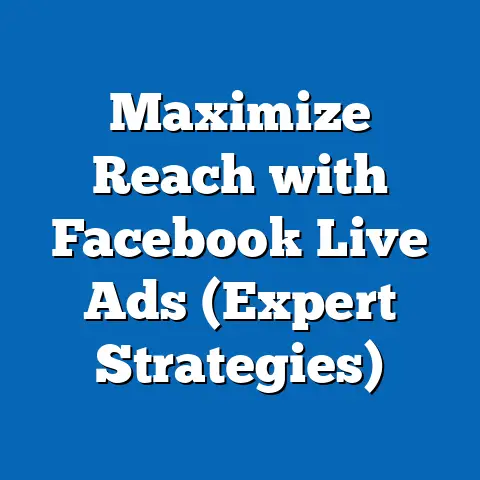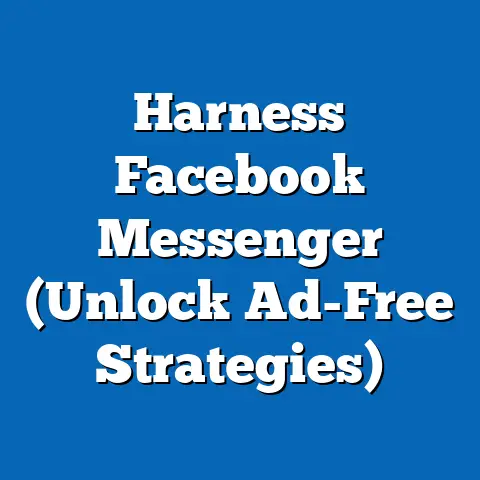Unlocking Facebook Ads CTR (Expert Insights Revealed)
In the vast digital landscape, reminiscent of Odysseus navigating treacherous seas, businesses today face an equally daunting challenge: capturing attention in an oversaturated online world. Among the myriad tools at their disposal, Facebook Ads stand as a lighthouse, guiding brands toward their target audiences with precision and scale. Yet, the key to success lies in mastering Click-Through Rate (CTR)—a metric that separates fleeting glances from meaningful engagement.
As of 2023, Facebook (now under Meta’s umbrella) boasts over 2.9 billion monthly active users, making it one of the largest advertising platforms globally (Statista, 2023). With businesses spending upwards of $50 billion annually on Facebook Ads, the competition for user attention is fiercer than ever (eMarketer, 2023). However, the average CTR for Facebook Ads across industries hovers at a mere 0.90%, underscoring the difficulty of standing out (WordStream, 2023).
Section 1: Understanding Click-Through Rate (CTR) in Facebook Ads
What is CTR and Why Does It Matter?
Click-Through Rate (CTR) measures the percentage of users who click on an ad after seeing it, calculated as (Clicks ÷ Impressions) × 100. It serves as a critical indicator of an ad’s relevance and appeal to its audience. A higher CTR not only signifies effective creative and targeting but also reduces cost-per-click (CPC), as Meta rewards engaging ads with better ad placement and lower costs.
According to a 2023 report by Hootsuite, ads with a CTR above 1.2% are considered above average, while top-performing campaigns can achieve rates as high as 3-5% in niche industries. Conversely, a low CTR signals wasted ad spend and missed opportunities, often prompting marketers to rethink their strategy. Understanding CTR is the first step to unlocking the potential of Facebook Ads.
Historical Trends in Facebook Ads CTR
Over the past decade, CTRs for Facebook Ads have fluctuated due to changes in user behavior, algorithm updates, and increased competition. In 2015, the average CTR was around 1.5%, buoyed by less ad clutter and higher organic reach (AdEspresso, 2016). However, as ad volume grew—Meta reported a 20% year-over-year increase in ad impressions by 2020—average CTRs dipped to below 1% by 2021 (Meta Quarterly Reports, 2021).
The introduction of privacy-focused updates, such as Apple’s iOS 14.5 App Tracking Transparency (ATT) in 2021, further complicated targeting, contributing to a temporary dip in CTRs by 15% for some industries (Forbes, 2021). Yet, by 2023, marketers adapting to new tools like Meta’s Advantage+ campaigns have reported a gradual recovery, with CTRs stabilizing around 0.9-1.0% (WordStream, 2023). These trends highlight the importance of agility in navigating platform changes.
Demographic Differences in CTR Performance
Not all audiences engage with Facebook Ads equally, and demographic data reveals stark differences in CTR. For instance, users aged 18-24 consistently show higher engagement, with an average CTR of 1.2%, compared to users aged 55+ who average just 0.5% (Sprout Social, 2023). This gap likely reflects younger users’ comfort with digital platforms and higher exposure to mobile-first content.
Gender also plays a role, with women slightly outperforming men in CTR (0.95% vs. 0.85%) across most industries, possibly due to differences in browsing habits and content preferences (AdEspresso, 2023). Geographically, emerging markets like India and Brazil report higher CTRs (1.1-1.3%) compared to saturated markets like the U.S. (0.8%), driven by lower ad fatigue and growing internet penetration (Statista, 2023). Tailoring campaigns to these demographic nuances is essential for maximizing impact.
Section 2: Key Factors Influencing Facebook Ads CTR
Creative Elements: The Visual and Textual Hook
The ad creative—comprising images, videos, and copy—is often the make-or-break factor for CTR. Research from Meta indicates that ads with high-quality visuals achieve up to 40% higher CTRs than those with generic or low-resolution imagery (Meta Business Insights, 2022). Videos, in particular, have surged in effectiveness, with a 2023 study by Socialbakers reporting that video ads average a 1.2% CTR compared to 0.7% for static images.
Ad copy also plays a pivotal role. Short, action-oriented headlines (under 40 characters) paired with clear calls-to-action (CTAs) like “Shop Now” or “Learn More” boost CTR by 20-30% (WordStream, 2023). Testing multiple creative variations through A/B testing remains a proven method to identify winning combinations.
Targeting Precision: Reaching the Right Audience
Effective targeting is the backbone of a high CTR. Meta’s detailed targeting options—based on interests, behaviors, and demographics—allow advertisers to hone in on niche audiences, often yielding CTRs 50% higher than broad campaigns (AdEspresso, 2023). However, post-iOS 14.5, signal loss has pushed marketers toward broader targeting and lookalike audiences, which still deliver a respectable 1.0% CTR when optimized (Meta, 2023).
Retargeting campaigns, which focus on users who have previously interacted with a brand, consistently outperform cold audiences, with CTRs averaging 2-3% (Hootsuite, 2023). Leveraging first-party data and Meta’s Custom Audiences tool can help bridge the gap caused by privacy restrictions.
Ad Placement and Format: Where and How Ads Appear
Placement significantly impacts CTR, with mobile placements (especially in Stories and News Feed) outperforming desktop by 25% due to higher user engagement on smartphones (Socialbakers, 2023). Stories Ads, in particular, have emerged as a powerhouse, boasting a 1.5% average CTR compared to 0.8% for News Feed ads (Meta, 2023).
Ad format also matters. Carousel ads, which showcase multiple products or features, achieve a 1.1% CTR on average, while single-image ads lag at 0.9% (WordStream, 2023). Experimenting with placements and formats can uncover untapped opportunities for engagement.
Seasonality and Industry Benchmarks
CTR varies by industry and time of year. For example, e-commerce ads peak during holiday seasons like Black Friday, with CTRs reaching 1.8-2.0%, compared to a yearly average of 1.1% (AdEspresso, 2023). Conversely, industries like finance and insurance struggle with lower CTRs (0.5-0.7%) due to complex decision-making processes (WordStream, 2023).
Understanding these benchmarks allows advertisers to set realistic goals and adjust budgets seasonally. A fitness brand, for instance, might capitalize on New Year’s resolution trends in January, while a retailer focuses on Q4 holidays.
Section 3: Expert Insights on Boosting Facebook Ads CTR
Insight 1: Leverage Emotional Storytelling
Experts like digital marketing strategist Amy Porterfield emphasize the power of emotional resonance in ads. “People don’t buy products; they buy feelings,” she notes in a 2023 podcast. Ads that tell a story—whether through a relatable problem-solution narrative or humor—can increase CTR by up to 35% (HubSpot, 2023).
For example, a pet food brand sharing a heartwarming video of a rescued dog thriving on their product saw a 2.5% CTR, far above the industry average of 1.0% (Case Study, AdEspresso, 2023). Crafting emotionally compelling content requires understanding audience pain points and aspirations.
Insight 2: Optimize for Mobile-First Experiences
With 98.5% of Facebook users accessing the platform via mobile devices, mobile optimization is non-negotiable (Statista, 2023). Marketing consultant Neil Patel advises using vertical formats (9:16 ratio) for Stories and Reels, as they align with natural scrolling behavior, boosting CTR by 20% (Patel, 2023). Fast-loading creatives and concise messaging also prevent drop-off on smaller screens.
Insight 3: Test, Analyze, and Iterate
Continuous testing is a mantra echoed by experts like Larry Kim, founder of WordStream. “Only 10% of your ads will drive 90% of your results,” Kim states in a 2023 webinar. Running split tests on variables like headlines, images, and CTAs can identify high-performers, with top campaigns often doubling their initial CTR after optimization (WordStream, 2023).
Meta’s built-in A/B testing tool and third-party analytics platforms like Google Analytics provide actionable data to refine strategies. Consistency in testing ensures long-term improvement.
Insight 4: Use Dynamic Ads for Personalization
Dynamic ads, which automatically tailor content based on user behavior, are a game-changer for CTR. According to Meta, dynamic product ads for e-commerce achieve a 1.5% CTR, 50% higher than static ads (Meta Business Insights, 2023). Experts recommend integrating dynamic ads with robust product catalogs and retargeting to maximize relevance.
Section 4: Data Visualization and Case Studies
Visualizing CTR Trends (Description)
Imagine a line graph depicting average Facebook Ads CTR from 2015 to 2023. The line starts at 1.5% in 2015, peaks slightly in 2017 at 1.6%, then gradually declines to 0.9% by 2021 following privacy updates, before stabilizing at 1.0% in 2023. A second overlay shows ad spend rising from $10 billion in 2015 to $50 billion in 2023, illustrating the inverse relationship between ad volume and CTR.
A complementary bar chart could break down CTR by demographic, with 18-24-year-olds at 1.2%, 25-34 at 1.0%, and 55+ at 0.5%, highlighting the youth engagement advantage. Such visualizations make complex trends accessible at a glance.
Case Study: E-Commerce Brand Success
A mid-sized e-commerce brand selling fitness gear revamped its Facebook Ads strategy in 2022, focusing on video creatives and retargeting. Initially, their CTR languished at 0.6%, below the industry average. After implementing dynamic video ads showcasing user testimonials and targeting past website visitors, their CTR soared to 2.1% within three months (AdEspresso Case Study, 2023).
The brand’s ad spend efficiency also improved, with CPC dropping from $0.80 to $0.45. This case underscores the power of combining creative innovation with precise targeting.
Section 5: Challenges and Pitfalls to Avoid
Ad Fatigue and Declining Engagement
Ad fatigue—when users see the same ad too often—can slash CTR by 40% within two weeks of a campaign (Socialbakers, 2023). Rotating creatives every 7-10 days and capping frequency at 2-3 impressions per user per week can mitigate this. Monitoring engagement metrics in Meta Ads Manager helps detect early signs of fatigue.
Over-Reliance on Broad Targeting
Post-privacy updates, some advertisers shifted to overly broad targeting, resulting in a 20% lower CTR compared to interest-based campaigns (Hootsuite, 2023). Balancing broad reach with lookalike audiences and interest layering can maintain relevance without sacrificing scale.
Ignoring Cost Metrics
Focusing solely on CTR without considering CPC or conversion rates can mislead campaigns. A high CTR with low conversions often indicates a mismatch between ad messaging and landing page experience. Experts recommend a holistic approach, tracking metrics like Cost Per Acquisition (CPA) alongside CTR.
Section 6: Future Trends and Broader Implications
The Rise of AI and Automation
Meta’s Advantage+ campaigns, powered by machine learning, are poised to redefine CTR optimization. Early adopters report a 15% uplift in CTR compared to manual campaigns, as AI dynamically adjusts targeting and creative delivery (Meta, 2023). As automation tools become mainstream, marketers must adapt to stay competitive.
Evolving Privacy Landscape
With global privacy regulations tightening, signal loss will continue to challenge precise targeting. However, Meta’s investments in on-platform measurement tools and first-party data solutions offer hope. Brands that prioritize transparency and user trust could see long-term gains in engagement.
Broader Implications for Digital Marketing
Unlocking higher CTRs on Facebook Ads is more than a tactical win—it reflects a brand’s ability to connect with audiences in a crowded digital space. As competition intensifies, mastering CTR will separate thriving businesses from those left behind. The insights and strategies discussed here are not just about clicks; they’re about building meaningful relationships in an era of fleeting attention.
Conclusion
Navigating the complexities of Facebook Ads CTR is akin to steering a ship through ever-changing waters. With average CTRs hovering at 0.9%, and top performers achieving 3-5%, the opportunity for improvement is vast. By leveraging creative storytelling, precise targeting, mobile optimization, and continuous testing, businesses can unlock higher engagement and efficiency.
The data and expert insights presented—drawn from sources like Meta, WordStream, and Statista—offer a roadmap for success. Historical trends show the impact of platform changes, while demographic patterns highlight the need for tailored approaches. As AI and privacy shape the future, adaptability will remain the cornerstone of effective advertising.
Ultimately, a high CTR is a stepping stone to deeper goals: brand loyalty, conversions, and growth. In the digital odyssey of modern marketing, mastering Facebook Ads CTR is not just a destination—it’s a journey of constant learning and innovation.

